Widespread tree death from beetle infestations, tree disease outbreaks affecting seed production.-
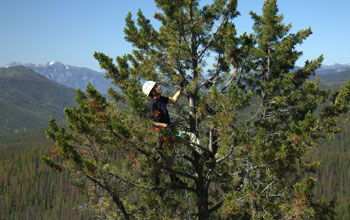
Ecologist Josh Rapp climbs a whitebark pine to sample cone-bearing branches.
Credit: Dash Donnelly
Download the high-resolution JPG version of the image. (693 KB)
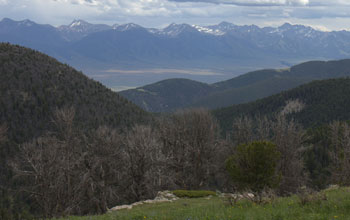
Whitebark pine trees killed by mountain pine beetle (foreground and on mountain).
Credit: Josh Rapp
Download the high-resolution JPG version of the image. (394 KB)
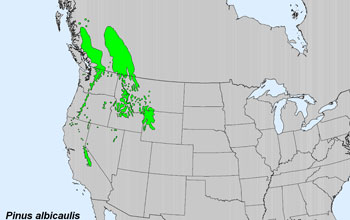
Current range of the whitebark pine tree: Will it soon be much smaller?
Credit: Wikimedia Commons
Download the high-resolution PNG version of the image. (184 KB)
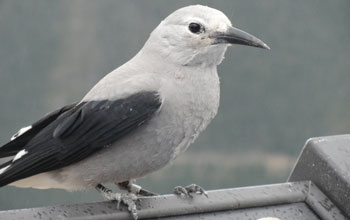
Clark's Nutcrackers are the main carriers of whitebark pine seeds to new areas.
Credit: Clarisse Hart
Download the high-resolution JPG version of the image. (4 MB)
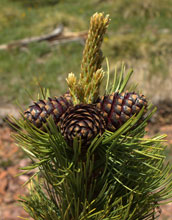
Whitebark pine seed cones are found in clusters of two-to-four cones at ends of branches.
Credit: Josh Rapp
Download the high-resolution JPG version of the image. (434 KB)
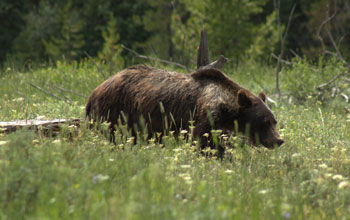
Grizzlies: likelier to come into conflict with humans when whitebark pine cone crops fail.
Credit: Josh Rapp
Download the high-resolution JPG version of the image. (412 KB)
There's trouble ahead for the whitebark pine, a mountain tree that's
integral to wildlife and water resources in the western United States
and Canada.
Over the last decade, some populations of whitebark
pines have declined by more than 90 percent. But these declines may be
just the beginning.
New research results, supported by the National Science Foundation (NSF) and published today in the Journal of Ecology,
suggest that as pine stands are increasingly fragmented by widespread
tree death, surviving trees may be hindered in their ability to produce
their usually abundant seeds.
"With fewer seeds, you get less
regeneration," says ecologist Joshua Rapp, affiliated with NSF's Harvard
Forest Long-Term Ecological Research (LTER) site and lead author of the
paper.
Whitebark pine populations vary between producing a high
number of seed cones some years, and a low number of seed cones other
years.
This variation depends on four factors: male pollen cones, female seed cones, wind and proximity.
Each year, pollen from male cones is carried on the air to fertilize female seed cones perched atop nearby trees.
"In
low-cone years, less pollen is released, reaching extremely few female
cones," says Elizabeth Crone, senior ecologist at the NSF Harvard Forest
LTER site and co-author of the paper.
"But as more and more whitebark pines die, every year becomes a low-cone year."
In isolated pockets of trees, the gene pool is also diminished, meaning the seeds produced may be less viable over time.
"For
decades, researchers have struggled to understand why many different
organisms--trees, fish, corals, insects--from various habitats reproduce
synchronously and at certain intervals," says Saran Twombly, program
director in NSF's Division of Environmental Biology, which funded the
research.
"By combining field data on seed and pollen production
for whitebark pines with models that simulate mature cone production,
this study helps to answer that question for these pines."
To reach their conclusions, the scientists had to look back in time.
They
inspected branches from seven whitebark pine sites in western Montana,
counting the scars left by pollen cones and seed cones.
"All the
years with a high number of seed cones had one thing in common: a high
number of pollen cones," says Rapp. "The success of the seeds seems to
depend on the amount of pollen produced."
Whitebark pine seeds are an essential food source for many animals in mountain habitats.
The
Clark's Nutcracker, a mountain bird, can store up to 100,000 seeds in
underground caches each year. Squirrels also store thousands of seeds
underground.
A diminished number of seed cones has an effect on
grizzly bears, the scientists say; the bears regularly raid squirrel
seed caches to prepare for winter hibernation.
"In the past, low
years for whitebark pine cones have led to six times more conflicts
between grizzlies and humans, as hungry bears look for food in
campgrounds," says Crone.
"Now, concerns about viability of
whitebark pine populations are one of the main reasons grizzly bears in
Yellowstone National Park are still listed as threatened under the
Endangered Species Act."
Birds, squirrels and bears are not the only species that depend on whitebark pine.
Vast
stands of whitebark pine help to maintain the mountain snowpacks that
provide water to more than 30 million people in 16 U.S. states each
year.
Whitebark pines are often the only trees at the highest
elevations. Their branches retain snow as it blows across gusty
mountaintops. Their shade moderates snow-melt in the spring, keeping
flows down the mountain in check.
A small percentage of whitebark
pine trees have outlived the ongoing destruction by pests and disease.
These trees are the next area of focus for Crone's team.
"We
want to find out whether the surviving trees are still producing cones,"
Crone says. "They represent the future of whitebark pines."
-NSF-
Media Contacts
Cheryl Dybas, NSF (703) 292-7734
cdybas@nsf.gov
Clarisse Hart, NSF Harvard Forest LTER Site (978) 756-6157
Clarisse Hart, NSF Harvard Forest LTER Site (978) 756-6157
Related WebsitesNSF Long-Term Ecological Research (LTER) Network:
http://www.lternet.edu
NSF Harvard Forest LTER Site:
NSF Harvard Forest LTER Site:
http://harvardforest.fas.harvard.edu/research/LTER
NSF Publication: Discoveries in Long-Term Ecological Research:
NSF Publication: Discoveries in Long-Term Ecological Research:
http://www.nsf.gov/pubs/2013/nsf13083/nsf13083.pdf?WT.mc_id=USNSF_25&WT.mc_ev=click
NSF Publication: Discoveries in Sustainability:
NSF Publication: Discoveries in Sustainability:
The National Science Foundation (NSF) is an independent federal
agency that supports fundamental research and education across all
fields of science and engineering. In fiscal year (FY) 2012, its budget
was $7.0 billion. NSF funds reach all 50 states through grants to nearly
2,000 colleges, universities and other institutions. Each year, NSF
receives about 50,000 competitive requests for funding, and makes about
11,500 new funding awards. NSF also awards about $593 million in
professional and service contracts yearly.
Useful NSF Web Sites:
NSF Home Page: http://www.nsf.gov
NSF News: http://www.nsf.gov/news/
For the News Media: http://www.nsf.gov/news/newsroom.jsp
Science and Engineering Statistics: http://www.nsf.gov/statistics/
Awards Searches: http://www.nsf.gov/awardsearch/
NSF Home Page: http://www.nsf.gov
NSF News: http://www.nsf.gov/news/
For the News Media: http://www.nsf.gov/news/newsroom.jsp
Science and Engineering Statistics: http://www.nsf.gov/statistics/
Awards Searches: http://www.nsf.gov/awardsearch/
The National Science Foundation (NSF).
Guillermo Gonzalo Sánchez Achutegui
ayabaca@gmail.com
ayaba@hotmail.com
ayabaca@yahoo.com
Inscríbete en el Foro del blog y participa : A Vuelo De Un Quinde - El Foro!

No hay comentarios:
Publicar un comentario